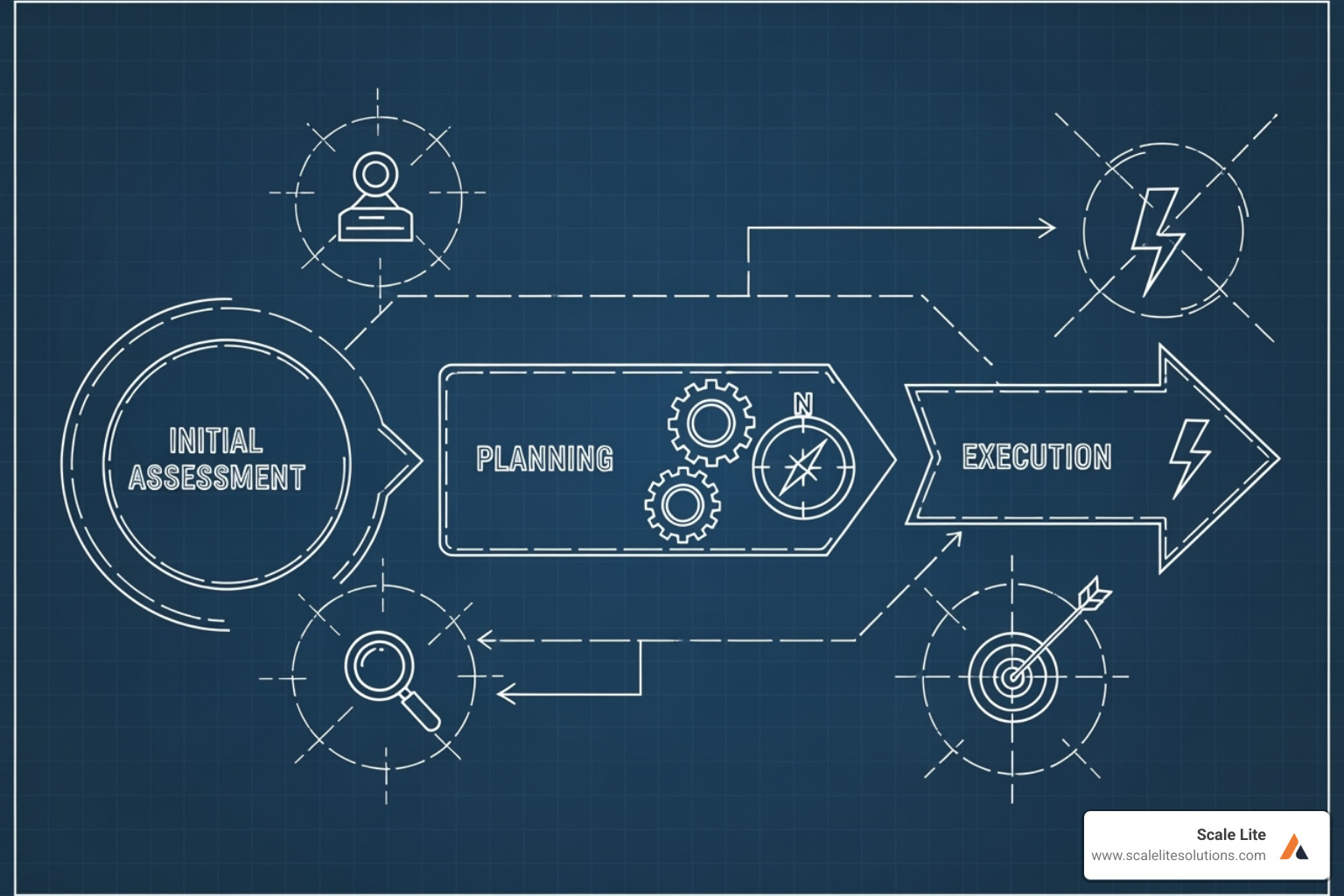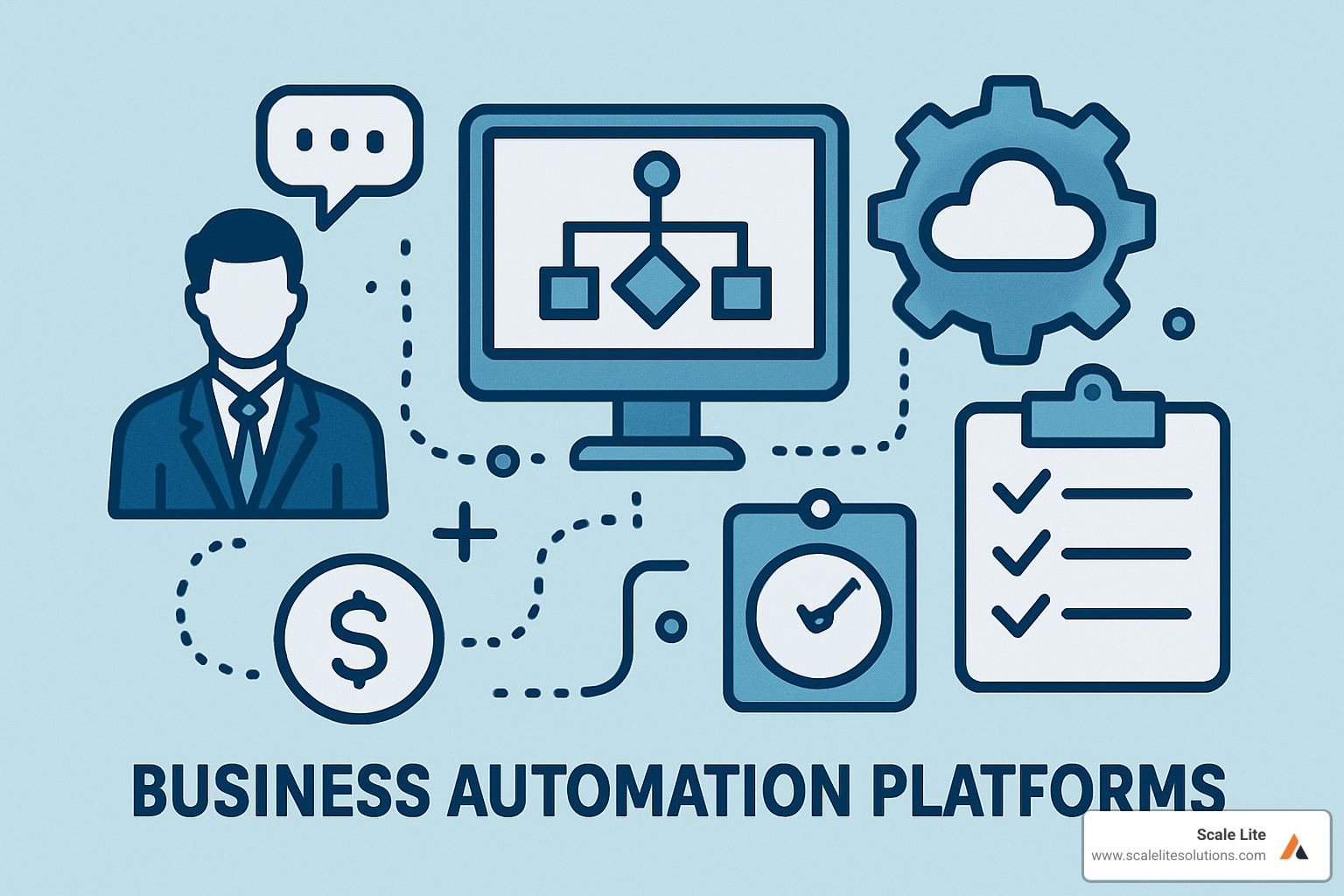
Unleash Growth: How AI is Reshaping the Business Landscape

Why AI Business Change Is Reshaping Every Industry
AI business change is a fundamental shift, moving beyond simple digitization to reimagine processes with intelligent automation and data-driven insights.
Key Components of AI Business Change:
- Strategic Integration: Embedding AI into core operations, not just as a tool
- Process Reimagination: Redesigning workflows around intelligent capabilities
- Data-Driven Decision Making: Using AI to analyze patterns and predict outcomes
- Automated Workflows: Reducing manual tasks while improving accuracy
- Improved Customer Experience: Personalizing interactions at scale
The numbers show the urgency of this shift. Research from Accenture reveals that 95% of organizations surveyed in 2024 have gone through more than two major changes in the past three years, with 61% experiencing more than four. Yet only 30% of executives express confidence in their ability to drive successful change.
This gap highlights a critical challenge. Traditional digital change efforts have fallen short—KPMG research shows that 51% of companies have not seen an increase in performance or profitability from digital investments. The difference? AI change isn't about digitizing existing processes; it's about reimagining them entirely.
The stakes are high. Organizations using AI strategically outperform competitors, yet the rate of abandoned AI initiatives has climbed from 17% to 42% in the past year, showing that execution is key.
I'm Keaton Kay, founder of Scale Lite. I've spent years helping service-based businesses steer complex changes. AI business change requires a different approach than past tech adoptions, focusing on intelligence-driven processes, not just digitization.

Beyond Digital: Understanding the AI Change Revolution

For years, much of what we've called "digital change" was simply putting old processes into new software.
As Brian Solis, Head of Global Innovation at ServiceNow, noted, we focused more on digitalization than on actual change. We digitized existing processes instead of reimagining them, a practice better described as digital reformation.
The results are telling: KPMG research shows that 51% of companies have not seen an increase in performance or profitability from digital investments. We focused on making existing processes faster, not better. We moved our filing cabinets to the cloud but kept the same inefficient system.
AI business change is different. It's not about digitizing what you already do—it's about reimagining what's possible when intelligence becomes part of everything you do.
Digital change gave us faster calculators. AI change gives us systems that predict future needs, identify anomalies, and suggest better solutions.
This shift requires moving beyond the siloed thinking that has dominated business for decades. AI finds connections between sales data, customer interactions, and maintenance logs that humans might miss, creating an integrated enterprise where intelligence flows freely.
| Digital Change | AI Change |
|---|---|
| Process-focused - digitizing existing workflows | Intelligence-focused - reimagining with smart automation |
| Data as a byproduct of digital processes | Data as the core asset, fueling learning and insights |
| Siloed improvements within departments | Integrated enterprise-wide change |
| Reactive approach - fixing problems after they happen | Proactive insights - preventing problems before they start |
What is AI Change?
AI business change is a strategic initiative that weaves artificial intelligence into the fabric of your entire operation. It's about integrating AI into operations in ways that fundamentally change how you work.
This means driving both innovation and efficiency. You find new ways to serve customers, manage resources, and grow, sometimes even creating new business models. The goal is optimizing workflows for a more responsive, predictable, and profitable business. With Data-Driven Decision Making, you use intelligence to anticipate customer needs.
The Core Technologies Powering the Shift
Here are the core technologies making this intelligence revolution possible:
Machine Learning gets smarter with more data, improving its ability to predict equipment failures, understand customer behavior, and optimize schedules.
Natural Language Processing (NLP) allows computers to understand human language, enabling systems to analyze feedback, summarize reports, and assist with human-like communication.
Generative AI creates new content, such as marketing copy, reports, and training materials. It acts as a tireless creative assistant.
Computer Vision gives machines sight to inspect quality, monitor safety, and diagnose equipment issues by spotting problems humans might miss.
Automation becomes intelligent with AI, allowing systems to learn and adapt. Business Automation Platforms can now handle complex decisions, not just repetitive tasks.
IoT integrations connect physical assets to digital intelligence. Equipment sensors can predict maintenance, track inventory, or monitor environmental conditions.
Together, these technologies create a business that learns, adapts, and improves with every interaction.
Crafting Your AI Strategy: From Vision to Execution

Deploying AI isn't like buying a new truck; it requires a clear strategy, much like a blueprint is needed before building a house. Successful changes focus on business value, not just technology. They consider how AI will reshape operating models and how the company culture must adapt. This approach is key to successful Operational Excellence Strategies.
The journey unfolds in three stages: exploration, commitment, and full-scale change.
Stage 1: Assess and Define Your AI Business Change Goals
First, assess your current situation. Don't find AI tools and then look for problems; that approach leads to costly mistakes. Start with information gathering on current operations to find time-consuming processes, common mistakes, and frustrating bottlenecks. The goal is identifying high-impact problems that AI can genuinely solve.
This also involves assessing our current resources: data quality and accessibility, and team technology skills. An honest assessment is crucial. With this understanding, define clear objectives and metrics. Set specific targets like "reduce invoice processing time by 50%." This specificity forms the business case for a solid Data-Driven Business Strategy.
Stage 2: Build the Roadmap and Commit
With problems and goals defined, the next challenge is prioritizing initiatives. Avoid the temptation to tackle everything at once. Choosing the right AI projects means focusing on a few high-impact areas to deliver measurable value and prevent overwhelm.
Securing executive sponsorship is critical. Without strong leadership buy-in, initiatives can get sidelined. Leaders must champion the change.
As Professor Rita McGrath of Columbia Business School advises, take a step-by-step approach. This allows you to start small, test assumptions, and learn, building capability and confidence gradually. Early wins create momentum for larger initiatives, paving the way for enterprise-wide change.
Stage 3: Execute and Infuse AI Across the Enterprise
Execution begins with data collection and management. AI is only as good as its data, so quality and accessibility are paramount. Next is building and tuning models to solve identified problems, like training a system to predict equipment failure or developing algorithms for route optimization.
The magic happens when you integrate AI into existing workflows. AI-Driven Workflow Automation becomes a competitive advantage by embedding intelligence into tools people already use.
Once pilots are successful, scale them strategically. This isn't copy-pasting solutions; it's adapting lessons learned and frameworks for different departments. Throughout this phase, measure impact and iterate. AI change is an ongoing process of refinement where both systems and people improve.
The goal is to create an organization that operates with intelligence at its core, changing how you serve customers, manage operations, and grow.
AI in Action: Practical Use Cases for Modernizing Your Business

Business owners want concrete examples of AI business change. The good news is that AI is already changing businesses in every industry, including traditional service companies. Practical AI applications can Improve Business Operations and directly impact your bottom line, and you don't need to be a tech giant to benefit.
Core Operations and Supply Chain
Predictive maintenance uses sensor data to predict equipment failure before it happens. This prevents costly downtime and repairs by alerting you to maintenance needs in advance.
Route optimization uses AI algorithms to analyze real-time traffic, weather, and job locations to create the most efficient routes. This saves fuel and allows technicians to complete more service calls daily.
Inventory management uses AI to learn your usage patterns and seasonal fluctuations to prevent overstocking or stockouts. This frees up cash and prevents lost sales, an approach mastered by companies like Amazon, which uses AI to anticipate stock shortages.
Demand forecasting helps you prepare for busy seasons, allocate staff, and adjust pricing. This contributes to Business Process Streamlining across your operation.
Customer Service and Sales
24/7 automated support with intelligent chatbots handles routine questions, freeing your team for complex issues. Modern chatbots understand context and can escalate to a human when needed, providing customers with instant help.
Personalized customer interactions are possible at scale with AI analyzing customer history and preferences. A service rep can know a customer's appointment preferences and past service history, building loyalty.
Sentiment analysis analyzes customer feedback from reviews and support tickets to spot trends and potential issues before they escalate.
Product and service recommendations use AI to identify opportunities for upselling or cross-selling relevant services, increasing revenue while benefiting the customer.
Lead qualification analyzes and scores inbound leads based on their likelihood to convert. This allows your sales team to focus on the most promising prospects, helping to Streamline Operational Processes that drive revenue.
Back-Office Functions (IT, HR, Marketing)
Administrative task automation handles tedious tasks like data entry, scheduling, and invoice processing automatically, freeing your team for growth-focused activities.
IT modernization is boosted by AI-powered code generation and system analysis, helping to streamline software systems and identify improvements.
Talent acquisition is more efficient with AI screening resumes, scheduling interviews, and answering candidate questions, helping you find the best people faster.
Marketing content creation with generative AI can quickly create social media posts, emails, and website copy, allowing you to test what resonates with your audience.
Market trend analysis uses AI to analyze vast amounts of data, providing insights into emerging trends, competitor strategies, and customer behavior.
These applications work together, creating a compound effect that transforms your business. It's about making your team more effective, allowing them to focus on building relationships, solving complex problems, and driving innovation.
Overcoming the Problems of Your AI Business Change
AI business change is exciting, but most organizations face roadblocks. These challenges are manageable if you know what to expect. Common problems include scaling pilots, data governance, managing organizational change, and upskilling teams. These are critical for any SME Business Change involving AI.
The Human Element: Fostering an AI-Ready Culture
Many leaders mistakenly see AI business change as a technology challenge, but it's fundamentally a people challenge. The biggest obstacle is helping your team adapt to new ways of working.
Change starts at the top. Leaders must model the behavior they want to see by using AI tools, making data-driven decisions, and showing enthusiasm for the change. Shift away from legacy mindsets that view automation as a threat. Help people see AI as an intelligent assistant. Building a network of internal change champions can help get buy-in from skeptical team members.
Accenture's concept of the human plus agentic workforce describes how people and AI can work together seamlessly. This makes your team's job more strategic and creative. Emphasize collaboration over replacement. When people see AI handling tedious tasks, allowing them to focus on problem-solving and customer relationships, resistance decreases.
The Technical Foundation: Data, Governance, and Scaling
Beyond culture, you need a solid technical foundation. AI requires good, clean data. Scattered, inconsistent, or poorly maintained data will cause AI initiatives to struggle. Breaking down data silos is a major hurdle. AI thrives on comprehensive information, so you need systems where data flows freely but securely.
Data governance is critical. Clear policies on data quality, privacy, and error handling prevent future problems and build trust. Avoid "pilot purgatory," where successful pilots fail to scale. Successful AI business change requires planning for scalability from day one.
Critical Steps for Leaders
To succeed, leaders should focus on five areas:
- Set a clear vision for change that connects AI to your company's core mission.
- Invest heavily in upskilling and reskilling your team to help them feel confident and prepared.
- Model new, data-driven behaviors yourself to show your commitment.
- Personalize the change effort for different teams by tailoring communication and training.
- Measure impact and iterate relentlessly, adjusting your course based on real-world results.
Frequently Asked Questions about AI Change
Here are answers to common questions about AI business change.
How do I start with AI if my business is in a low-tech industry?
You don't need to be a tech company to benefit from AI. Traditional industries like construction and HVAC see impressive results. Start small by focusing on one specific problem, like inefficient scheduling, poor inventory management, or inconsistent customer follow-up.
Identify the bottleneck and find a user-friendly tool to solve it. For example, a smart scheduling system can optimize routes, and an inventory tool can predict supply needs. You don't need to build anything from scratch.
The goal isn't to revolutionize everything overnight. Aim for a quick win that shows real value. Success builds confidence and support for the next challenge.
Will AI replace my employees?
This is a common concern. AI business change is about making your team more powerful, not obsolete. AI acts as a smart assistant, handling repetitive tasks like data analysis. It can't replace human skills like building customer relationships, on-site problem-solving, or using intuition based on experience.
AI takes over tedious tasks, freeing your team for creative problem-solving, building customer trust, and using their expertise on complex issues. Roles will evolve, and new skills will be needed. However, businesses often find they need more people, not fewer, as AI helps them grow and serve more customers.
How do I measure the success of an AI initiative?
To measure AI success, define your metrics before you start. Many businesses skip this step and later question their investment's value.
Identify the specific problem and its success metrics. For inefficient routes, measure fuel costs or miles driven. For customer service, track response times or satisfaction scores.
Establish your baseline first. Document current metrics like route times, fuel costs, or customer satisfaction scores for later comparison. Track these metrics regularly. This data-driven approach shows what's working, helps you refine your strategy, and proves the value of your investment.
Success often comes from small, consistent improvements over time.
Conclusion: The Future is an AI-Powered Enterprise
This guide has shown that AI business change is about more than new technology; it's about sustainable growth and building a lasting competitive advantage. It's a shift toward an intelligence-driven future where businesses thrive on change.
This intelligence revolution levels the playing field, giving small and medium-sized businesses access to powerful tools once reserved for tech giants. A local service company can now use predictive maintenance, route optimization, and accurate demand forecasting.
The key is continuous evolution and developing an AI-first mindset. Constantly look for ways to weave intelligence into operations, turning every process into an opportunity to improve.
At Scale Lite, we've seen this journey's transformative power for service businesses and companies in low-tech industries. We know you're focused on solving customer problems, not becoming a tech expert. That's where we help.
Our holistic approach combines AI deployment, workflow automation, data gathering through smart technology configuration, and CRM optimization to create a comprehensive change that drives genuine enterprise value. We don't just implement tools; we help you reimagine how your entire organization operates.
Future leaders will be businesses that evolve their entire organizational DNA, seeing AI as a powerful amplifier of human capability, not a threat.
Your journey to an AI-powered enterprise requires a clear strategy, the courage to challenge existing processes, the wisdom to start small, and the patience to build a supportive culture. The future belongs to businesses that can adapt, learn, and evolve. The question isn't whether AI will reshape your industry—it's whether you'll be leading that change or scrambling to catch up.
Ready to begin? Explore our Digital Change Services to begin your journey toward becoming the AI-powered enterprise your customers and competitors will admire.






